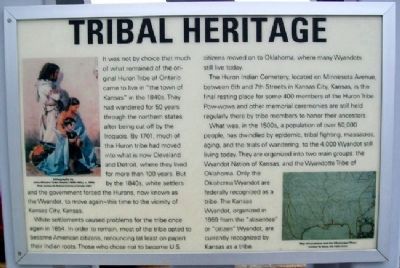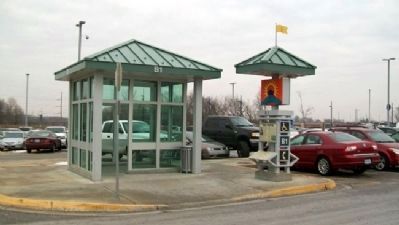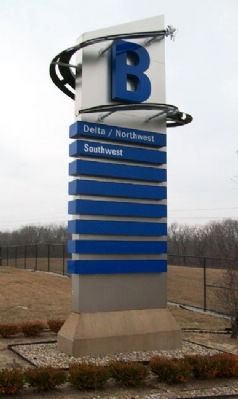Kansas City in Platte County, Missouri — The American Midwest (Upper Plains)
Tribal Heritage
It was not by choice that much of what remained of the original Huron Tribe of Ontario came to live in “the town of Kansas” in the 1840s. They had wandered for 50 years through the northern states after being cut off by the Iroquois. By 1701, much of the Huron tribe had moved into what is now Cleveland and Detroit, where they lived for more than 100 years. But by the 1840s, white settlers and the government forced the Hurons, now known as the Wyandot, to move again – this time to the vicinity of Kansas City, Kansas.
White settlements caused problems for the tribe once again in 1854. In order to remain, most of the tribe opted to become American citizens, renouncing (at least on paper) their Indian roots. Those who chose not to become U.S. citizens moved on to Oklahoma, where many Wyandots still live today.
The Huron Indian Cemetery, located on Minnesota Avenue, between 6th and 7th Streets in Kansas City, Kansas, is the final resting place for some 400 members of the Huron Tribe. Pow-wows and other memorial ceremonies are still held regularly there by tribe members to honor their ancestors.
What was, in the 1500s, a population of over 50,000 people, has dwindled by epidemic, tribal fighting, massacres, aging, and the trials of wandering, to the 4,000 Wyandot still living today. They are organized into two main groups: the Wyandot Nation of Kansas, and the Wyandotte Tribe of Oklahoma. Only the Oklahoma Wyandot are federally recognized as a tribe. The Kansas Wyandot, organized in 1959 from the “absentee” or “citizen” Wyandot, are currently recognized by Kansas as a tribe.
Erected by Kansas City International Airport. (Marker Number B1.)
Topics. This historical marker is listed in this topic list: Native Americans. A significant historical year for this entry is 1701.
Location. 39° 18.939′ N, 94° 42.156′ W. Marker is in Kansas City, Missouri, in Platte County. Marker is at Passenger Kiosk B1, in Economy Parking Lot B, at Kansas City International Airport, 601 Brasilia Avenue. Touch for map. Marker is in this post office area: Kansas City MO 64153, United States of America. Touch for directions.
Other nearby markers. At least 8 other markers are within walking distance of this marker. The Liberty Memorial (about 300 feet away, measured in a direct line); Atkins Gift (about 400 feet away); Hale: The Firepole (about 500 feet away); Happy Trails (about 600 feet away); Airport History (about 600 feet away); KC's Baseball Story (about 600 feet away); KC: On Flight (about 700 feet away); Home of BBQ (approx. 0.2 miles away). Touch for a list and map of all markers in Kansas City.
More about this marker. The Economy Parking Lots' passenger kiosks each have unique historical markers and flashy artwork to help passengers remember where they parked.
Also see . . .
1. Native American Tribes of Missouri. (Submitted on June 6, 2011, by William Fischer, Jr. of Scranton, Pennsylvania.)
2. Native American Tribes of Kansas. (Submitted on June 6, 2011, by William Fischer, Jr. of Scranton, Pennsylvania.)
Credits. This page was last revised on June 14, 2022. It was originally submitted on June 6, 2011, by William Fischer, Jr. of Scranton, Pennsylvania. This page has been viewed 594 times since then and 10 times this year. Last updated on May 3, 2020, by Clifford D. of Platte City, Missouri. Photos: 1, 2, 3, 4. submitted on June 6, 2011, by William Fischer, Jr. of Scranton, Pennsylvania. • Devry Becker Jones was the editor who published this page.



